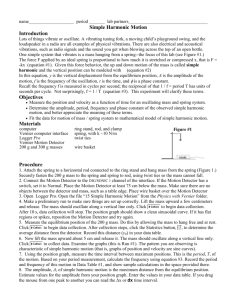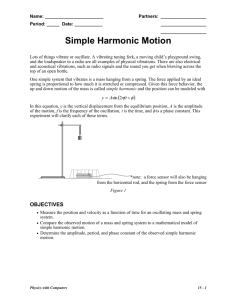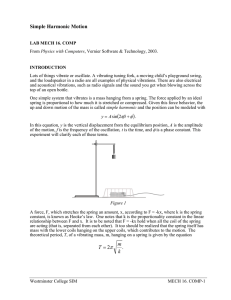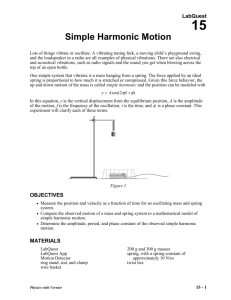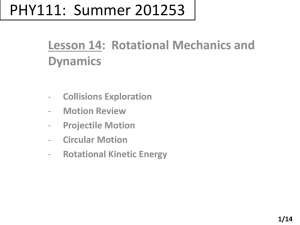Experiment: Simple Harmonic Motion
advertisement
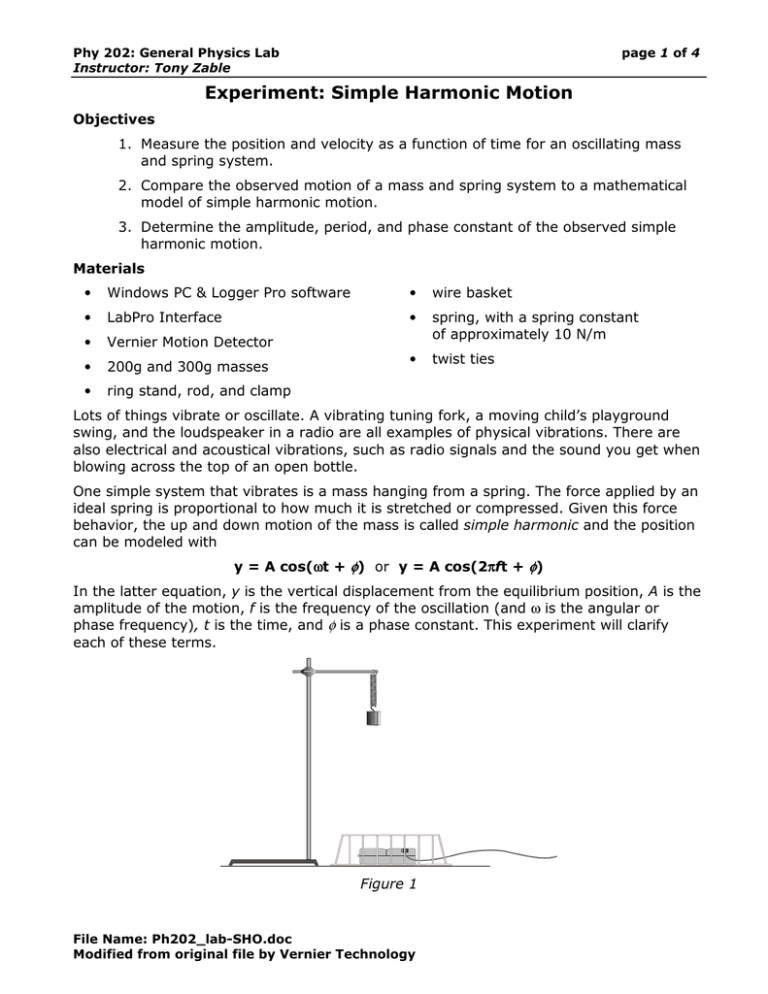
Phy 202: General Physics Lab Instructor: Tony Zable page 1 of 4 Experiment: Simple Harmonic Motion Objectives 1. Measure the position and velocity as a function of time for an oscillating mass and spring system. 2. Compare the observed motion of a mass and spring system to a mathematical model of simple harmonic motion. 3. Determine the amplitude, period, and phase constant of the observed simple harmonic motion. Materials • Windows PC & Logger Pro software • wire basket • LabPro Interface • • Vernier Motion Detector spring, with a spring constant of approximately 10 N/m • 200g and 300g masses • twist ties • ring stand, rod, and clamp Lots of things vibrate or oscillate. A vibrating tuning fork, a moving child’s playground swing, and the loudspeaker in a radio are all examples of physical vibrations. There are also electrical and acoustical vibrations, such as radio signals and the sound you get when blowing across the top of an open bottle. One simple system that vibrates is a mass hanging from a spring. The force applied by an ideal spring is proportional to how much it is stretched or compressed. Given this force behavior, the up and down motion of the mass is called simple harmonic and the position can be modeled with y = A cos(ω ωt + φ) or y = A cos(2π πft + φ) In the latter equation, y is the vertical displacement from the equilibrium position, A is the amplitude of the motion, f is the frequency of the oscillation (and ω is the angular or phase frequency), t is the time, and φ is a phase constant. This experiment will clarify each of these terms. Figure 1 File Name: Ph202_lab-SHO.doc Modified from original file by Vernier Technology Phy 202: General Physics Lab Instructor: Tony Zable page 2 of 4 Preliminary Questions 1. Attach the 200-g mass to the spring and hold the free end of the spring in your hand, so the mass and spring hang down with the mass at rest. Lift the mass about 10 cm and release. Observe the motion. Sketch a graph of position vs. time for the mass. 2. Just below the graph of position vs. time, and using the same length time scale, sketch a graph of velocity vs. time for the mass. Procedure 1. Attach the spring to a horizontal rod connected to the ring stand and hang the mass from the spring as shown in Figure 1. Securely fasten the 200g mass to the spring and the spring to the rod, using twist ties so the mass cannot fall. 2. Connect the Motion Detector to Ch1 of the LabPro interface then start the LoggerPro software. 3. Open the Vernier experiment file “15 Simple Harmonic Motion”. 4. Place the Motion Detector at least 75 cm below the mass. Make sure there are no objects near the path between the detector and mass, such as a table edge. Place the wire basket over the Motion Detector to protect it. 5. Make a preliminary run to make sure things are set up correctly. Lift the mass upward a few centimeters and release. The mass should oscillate along a vertical line only. Begin data collection. 6. After about 10s, data collection will stop. The position graph should show a clean sinusoidal curve. If it has flat regions or spikes, reposition the Motion Detector and try again. 7. Compare the position and velocity graphs to your sketched predictions in the Preliminary Questions. How are the graphs similar? How are they different? 8. With the 200g mass hanging at rest, begin data collection. After collection stops, use the statistics button, , to determine the average distance from the detector. Record this position (yo) in the data table. 9. Now lift the mass upward about 5 cm, release it and begin data collection. The mass should oscillate along a vertical line only. Examine the graphs. The pattern you are observing is characteristic of simple harmonic motion. File Name: Ph202_lab-SHO.doc Modified from original file by Vernier Technology Phy 202: General Physics Lab Instructor: Tony Zable page 3 of 4 10. Using the distance graph, measure the time interval between maximum positions. Record the period and frequency in the data table. 11. The amplitude, A, of simple harmonic motion is the maximum distance from the equilibrium position. Estimate values for the amplitude from your position graph. Enter the values in your data table. Click on the Examine button, , once again to turn off the examine mode. 12. Repeat Steps 8 – 11 with the same 200g mass, moving with greater amplitude than the first run. 13. Change the mass to 300 g and repeat Steps 7 – 11. Use an amplitude of about 5 cm. Keep a good run made with this 300-g mass on the screen. You will use it for several of the Analysis questions. Data Table Run Mass yo A T f (g) (cm) (cm) (s) (Hz) 1 2 3 Analysis 1. View the graphs of the last run on the screen. Compare the position vs. time and the velocity vs. time graphs. How are they the same? How are they different? 2. Turn on the Examine mode by clicking the Examine button, . Move the mouse cursor back and forth across the graph to view the data values for the last run on the screen. Where is the mass when the velocity is zero? Where is the mass when the velocity is greatest? 3. Does the frequency, f, appear to depend on the amplitude of the motion? Do you have enough data to draw a firm conclusion? 4. Does the frequency, f, appear to depend on the mass used? Did it change much in your tests? File Name: Ph202_lab-SHO.doc Modified from original file by Vernier Technology Phy 202: General Physics Lab Instructor: Tony Zable page 4 of 4 5. Compare your experimental data to a sinusoidal function using the Model feature of LoggerPro. Try it with your 300g data. a. In LoggerPro, select “Analyze”→”Model” from the Data menu. b. Scroll down and select the “Sine” function then click on the “Define Function” button. Modify the sine equation to reflect the simple harmonic motion equation in the introduction then re-name the function to “Cosine”. Click on “OK”. c. Adjust the model coefficients, to reflect your measured values for yo, A, and f. d. Note: Since data collection did not necessarily begin when the mass was at maximum distance from the detector, introduction of the “phase constant” φ is needed (represented by the “C” parameter in LoggerPro). The optimum value for φ will be between 0 and 2π. Set the “C” coefficient to a value that makes the model come as close as possible to your data. You may also need to adjust yo, A, and f to improve the fit. Write the equation that best matches your data. 7. What would happen to the plot of the model if you doubled the parameter for A? Sketch both the current model (from step 6) and the new model with doubled A. 8. Adjust the model equation by doubling the parameter for A to compare to your prediction. How does your prediction compare to the LoggerPro model? 9. How would the model graph change if you doubled f? Sketch both the original model (from step 6) and your prediction with doubled f. 10. Adjust the LoggerPro model to reflect doubled f. How does your prediction compare to the LoggerPro model? File Name: Ph202_lab-SHO.doc Modified from original file by Vernier Technology


